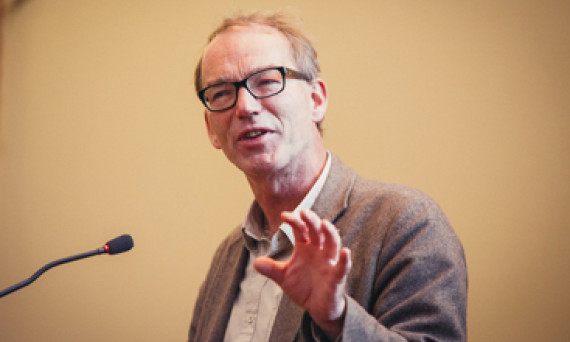Professor of social anthropology from the University of Oslo Thomas Hylland Eriksen spoke at the EUSP as part of the BP Professorship in the Anthropology of Migration and the regular meeting of the “Transnational and Migration Studies” seminar. Eriksen is the author of the book “What is Anthropology” (recently published in Russian) as well as books that have become classics of modern anthropology: “Ethnicity and Nationalism” and “Small Places—Large Issues.”
Professor Eriksen’s presentation was dedicated to the question of identity, which in an “overheated world” (as he calls global civilization after 1991) has turned into an identity crisis — the loss of contact with what man thinks and claims himself to be. This crisis presents a challenge to contemporary anthropology, which must actively participate in discussing the very “large issues” that are reflected in a variety of “small places”— such as an Australian mining town, a neighborhood in Oslo, or a plantation in Sierra Leone. Issues that, in an overheated world, stimulate its ever-increasing super-diversity—issues of population growth, energy consumption, the increasing mobility of immigrants and tourists, and the enormous progress in the speed of communications—all of which have opened new possibilities for comparative anthropological analysis. Such issues are reflected in Africa’s incredible population growth (excluding South Africa), where Internet use has been possible only for the past 7-8 years, or in the growing number of immigrants to Oslo since the early 1990s. In a period of time insignificant to their history, places like Nouakchott and Mogadishu have become cities with populations of more than a million people. What these changes signify on a human scale has become relevant to anthropology at its present stage.
Eriksen elaborated in detail on what super-diversity means for Oslo. Since 1991—a key temporal and social coordinate for him—Oslo has become an attractive labor market for immigrants. And while Poles currently represent the greatest number of immigrants there, the “immigrant” identity is attributed to Muslims—Pakistanis, Iraqis and Somalis. People’s identities are becoming indistinguishable, and borders, whether symbolic or real, are disappearing between large groups of immigrants living together (the “Jewish district” or “Indian area”), as are the constructs that were true to the world prior its state of super-diversity (a term coined by German anthropologist Steven Vertovec to describe 21st century London). Now the world is set into increasingly complex configurations that can be described with the help of two polar-opposite Norwegian towns not far from Oslo—Furuset and Kragerø. Furuset is a town of constructivist architecture whose population is about 70% immigrants—in certain schools, this number is near 100%. These immigrants cannot integrate into Norwegian society simply because they do not know a single Norwegian. Their social ties can be described by the term “uniplex relationships”: they know some people from work, others from the schools their children attend, and others through church. In its spatial and social organization Furuset presents an image of anti-Norway, one that is not seen in textbooks or tourist brochures. If we were to describe life in Furuset on a synchronic or diachronic scale, we would turn first to the category of mobility. Kragerø has the same number of people as Furuset, but represents a homogenous settlement where a sense of community is very clearly expressed through a variety of forms of social ties (multiplex relationships). Here, each community member appears to others as a multiplicity of his parental, neighborly and friendly relations and social networks, all intersecting and known to all—his profession is known, along with his grandfather’s. The pub-going and leisure activities characteristic to each person as well as the habits of the community as a whole are absolutely predetermined. These two examples clearly demonstrate what Norway—and not just Norway—was and became after 1991. In this Norway, the question of identity is as important for Norwegians as it is for immigrants. In essence it implies a choice between orientation toward the past or the future, toward tradition or the impulses from within the conscious, toward a feeling of safety or a feeling of freedom and the right to choose group unity or individual life styles. The main question at stake is how much can a Norwegian and a young Muslim woman have in common in order to create a common identity revealed through solidarity and community. Eriksen sees the answer not in unity but in cosmopolitanism—in a community of disagreement that alone can ensure dialogue between different forms and norms of social, professional, familial, and gender values, attitudes and roles. Anthropology’s societal role lies in engaging with structures that create different types of dialogues, common actions and solidarity. This is what we need today.
Olena Babkina














